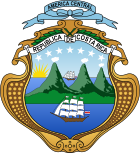| ||||||||||||||||||||||||||||||||
|
| ||||||||||||||||||||||||||||||||
Presidential election | ||||||||||||||||||||||||||||||||
| Turnout | 81.27% ( | |||||||||||||||||||||||||||||||
|---|---|---|---|---|---|---|---|---|---|---|---|---|---|---|---|---|---|---|---|---|---|---|---|---|---|---|---|---|---|---|---|---|
| ||||||||||||||||||||||||||||||||
 Results by canton | ||||||||||||||||||||||||||||||||
| ||||||||||||||||||||||||||||||||
All 57 seats in the Legislative Assembly 29 seats needed for a majority | ||||||||||||||||||||||||||||||||
This lists parties that won seats. See the complete results below.
| ||||||||||||||||||||||||||||||||
 |
|---|
|
|
General elections were held in Costa Rica on 5 February 1978.[1] Rodrigo Carazo Odio of the Unity Coalition won the presidential election, whilst his party also won the parliamentary election. Voter turnout was 81%.[2]
Carazo, a former congressman and former member of the National Liberation Party (probably Costa Rica's main political force), left the party several years before and created his own: Democratic Renovation, but a deeply split opposition on the 1974 election caused PLN's easy victory. With that in mind, main leaders of the non-Marxist opposition started talks in order to present a unified candidature.[3][4]
Eventually these talks came through and the main parties in the opposition at the right of the government achieved an agreement; going into a primary election to choose the common nominee. Rodrigo Carazo faced wealthy industrial Miguel Barzuna winning by small margin. Even when some leaders left the coalition after this (most notably Jorge Gonzalez Marten from the National Independent Party and former president Mario Echandi) most of the leadership remained united.[5] The Unity Coalition was created out of the joining of four parties: Carazo's Democratic Renovation, former president José Joaquín Trejos’ People's Union, Rafael Calderón Fournier (son of Calderonist leader Rafael Calderón Guardia) Republican Party and Dr. Jorge Arturo Monge's Christian Democratic Party (the smallest one of the coalition but the most ideologically coherent).[6]
The Left also made a coalition; the three main far-left parties at the Left of PLN; Popular Vanguard, Costa Rican Socialist Party and Revolutionary People's Movement made the United People coalition,[7] nominating former PLN member and doctor Rodrigo Gutierrez. Gutierrez had no possibilities to be president but the coalition did help the Left having a higher voting than usual and a large group in Congress. For many historians this election marks the beginning of Costa Rica's two-party system.[8]
- ^ Dieter Nohlen (2005) Elections in the Americas: A data handbook, Volume I, p 155 ISBN 978-0-19-928357-6
- ^ Nohlen, p 157
- ^ Casas-Zamora, Kevin (2005). Paying for Democracy: Political Finance and State Funding for Parties. ECPR Press. ISBN 978-0-9547966-3-1.[page needed]
- ^ "Elections and Events 1948-1986 1948". The Library. Retrieved 16 August 2016.
- ^ Lentz, Harris M. (4 February 2014). Heads of States and Governments Since 1945. Routledge. ISBN 9781134264902. Retrieved 16 August 2016.
- ^ Lehoucq, Fabrice (27 August 2012). The Politics of Modern Central America. ISBN 9780521515061. Retrieved 16 August 2016.
- ^ Ameringer, Charles D. (1992). Political Parties of the Americas, 1980s to 1990s. ISBN 9780313274183. Retrieved 16 August 2016.
- ^ White, Stephen; Webb, Paul (20 September 2007). Party Politics in New Democracies. Oxford University Press. ISBN 9780199289653. Retrieved 16 August 2016.


